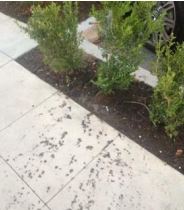Irrigation systems usually run when most people are asleep, so how can you tell if you have an irrigation leak?
UF/IFAS Miami U.C.U. (Urban Conservation Unit) remind us there is a “fine line between poor drainage, over irrigation & irrigation leaks.” However, since none of these are desirable, you need to investigate further if you see any of the geological signs below on your property.
Old Faithful: Water shooting up from ground
Unless you are drilling a well, water shooting up in the air is not a good sign. A hole in a mainline will run continuously and is usually obvious, but a broken irrigation head will only run when the zone cycles. Since more water is released from a broken irrigation head than a properly functioning irrigation head it can lead to the next three symptoms:
Niagara Falls: Water overflow
Water flowing over a curb when it is not raining is not a good sign. Any water flowing over a curb from irrigation is water being wasted and is a sign of over irrigation, a broken irrigation head or poor drainage.
Mississippi Delta: A fan of sediment deposit
If you remember your middle or high school class on geology, you may recall that when the Mississippi River flows into the Gulf of Mexico the sediment is deposited in an alluvial fan pattern.An alluvial fan pattern on a sidewalk or parking lot could be a sign of a broken irrigation head.
Grand Canyon: Erosion near irrigation heads
As previously mentioned, a broken irrigation head releases more water, which shoots up in the air. This water falls back to earth with a substantial amount of destructive energy. Depending on the type of soil and vegetation, there can be erosion. If an area surrounding an irrigation head is starting to show signs of erosion, the head may be cracked, broken or have a loose connection at the base.
The Grass is Greener on the Other Side of the Fence
Darker green spots or taller grass around an irrigation head is usually a sign of a problem. The irrigation head is likely cracked, broken or clogged. Green spots in the grass that are not near an irrigation head are typically caused by extra nitrogen usually from animal urine.
Green Slimy Curbs
If a slimy fungus starts to form on the curb you may be over irrigating (a lot!), or have a slow irrigation leak. To check for a slow irrigation leak read about The Spins below.
Water Reaganomics: The trickle-down effect
If you notice a little bit of water steadily coming out of an irrigation head long after the system has turned off, you may have a leaking irrigation valve. Most of the time irrigation valves work well. However, over time the diaphragm or solenoid in an irrigation valve can fail or debris can block the diaphragm from fully closing.
The Spins: A dial on the move
If you have a separate irrigation meter or sub meter, open the box and look for a small red or black dial or triangle. If it moves when the irrigation is not on, you have an irrigation leak that needs to be addressed.
About the Author: Alan Harris
Alan Harris is a water management pioneer. With roots in landscape architecture, Alan has worked with irrigation throughout his career experimenting with hydrozones and a variety of high efficiency irrigation systems.
Now, over thirty years in the landscape industry, Alan continues to stay apprised of the latest technology even in a sales leadership capacity as Valley Crest’s Director of Sales Operations for their landscape maintenance division. In addition to his contributions to this blog, Alan keeps his hand in water management as a regular contributor to Lawn & Landscape Magazine and speaker at WaterSmart Innovations Conference.

